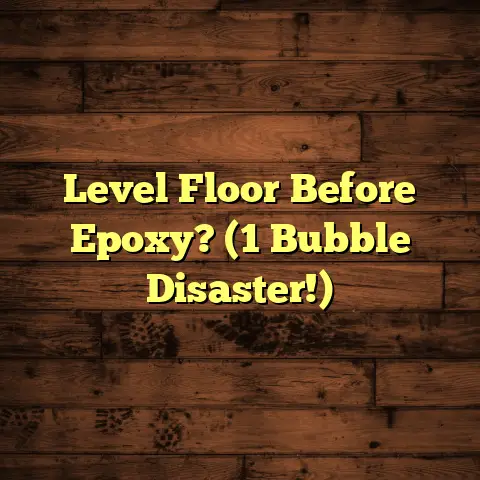Glue Down Vs Floating Laminate? (2 Install Gotchas!)
Isn’t it ironic that while we seek the
perfect flooring solution to anchor our homes,
the choice between glue down and floating
laminate often leaves us feeling like we’re
walking on shaky ground?
I’ve seen it happen
countless times.
Homeowners, bright-eyed and
eager, end up knee-deep in flooring woes,
all because they didn’t know the “gotchas”
lurking beneath the surface.
Introduction
Laminate flooring has surged in popularity,
mirroring the look of hardwood or tile at a
fraction of the cost.
It’s a fantastic option
for budget-conscious homeowners who don’t want
to compromise on style.
But here’s the kicker: the installation method
can make or break your laminate experience.
You’ve essentially got two main contenders:
glue down and floating.
Glue down involves adhering the planks directly
to the subfloor.
Floating, on the other hand,
uses interlocking planks that “float” above
the subfloor.
This article?
It’s your survival guide.
I’m going to walk you through both methods,
highlight their pros and cons, and, most
importantly, expose the common pitfalls
(the “gotchas”) that can turn your dream floor
into a nightmare.
Consider this your insider
knowledge, gleaned from years of installing,
repairing, and troubleshooting laminate floors.
Understanding Laminate Flooring
So, what exactly is laminate flooring?
It’s a multi-layered synthetic flooring product
fused together through a lamination process.
Think of it as a high-tech sandwich with
several key ingredients:
Wear Layer: The top layer, a transparent, protective coating that resists scratches, stains, and fading.
Its thickness, measured in mils, determines the floor’s durability.-
Design Layer: A high-resolution photographic image that mimics the look of wood, stone, or tile.
Core Layer: The heart of the laminate, typically made of high-density fiberboard (HDF) or medium-density fiberboard (MDF).
This layer provides stability and resistance to impact.-
Backing Layer: The bottom layer, designed to provide balance and protect against moisture from the subfloor.
The Benefits?
Laminate offers a compelling combination of advantages:
Cost-Effectiveness: Significantly cheaper than hardwood, tile, or stone.
According to HomeAdvisor, laminate flooring installation averages around \$4 to \$11 per square foot (including materials and labor), compared to \$8 to \$25 for hardwood.
[^1^]Variety: Laminate comes in a dizzying array of styles, colors, and textures.
You can find laminates that convincingly resemble almost any natural material.Durability: Laminate is surprisingly durable, especially when it comes to scratch and stain resistance.
It’s a great choice for high-traffic areas and homes with pets or children.
Installation Methods: A Closer Look
Glue Down: This method involves applying adhesive directly to the subfloor and then carefully positioning each plank.
It creates a strong, permanent bond, resulting in a very stable floor.Floating: With floating floors, the planks interlock via a tongue-and-groove system.
No adhesive is needed.
The entire floor “floats” above the subfloor, allowing for expansion and contraction.
Glue Down Laminate Flooring
What is Glue Down Laminate?
Glue down laminate is exactly what it sounds
like: laminate planks glued directly to the
subfloor.
It’s a more involved process than
floating, but it offers certain advantages.
Here’s a step-by-step breakdown of the installation:
Subfloor Preparation: This is crucial.
The subfloor must be clean, level, and dry.
Any imperfections will telegraph through the laminate.
I often use a self-leveling compound to smooth out minor dips and bumps.Adhesive Application: Using a trowel with the correct notch size (specified by the adhesive manufacturer), spread the adhesive evenly over a manageable section of the subfloor.
The type of adhesive is critical; use one specifically designed for laminate flooring.Plank Placement: Carefully position each plank, ensuring it’s properly aligned and tightly butted against the adjacent planks.
Use a rubber mallet to gently tap the planks into place, ensuring good contact with the adhesive.Rolling: After installing a section of planks, use a heavy floor roller to press the planks firmly into the adhesive.
This ensures a strong bond and eliminates air pockets.
Advantages of Glue Down
Stability: Glue down laminate is incredibly stable.
It’s less prone to movement or shifting, even in high-traffic areas.-
Noise Reduction: The adhesive layer helps to dampen sound transmission, making glue down floors quieter than floating floors.
Radiant Heating Compatibility: Glue down laminate is generally a better choice for use with radiant heating systems.
The direct contact with the subfloor allows for more efficient heat transfer.
Common Install Gotchas (First Gotcha)
Here’s the big one: Moisture Issues.
Moisture is the enemy of glue down laminate.
If the subfloor isn’t properly prepared, or if
there’s excessive moisture present, the adhesive
may not bond properly, leading to bubbling,
warping, and eventual failure of the floor.
I remember one job where the homeowner insisted
on installing glue down laminate in a basement
that had a history of minor water seepage.
Despite my warnings, they went ahead with the
installation.
Within a few months, the laminate
started to buckle and peel up in several areas.
The cost to remove the damaged flooring and
reinstall it properly was significant.
Remedies and Tips
Moisture Testing: Before even thinking about installing glue down laminate, test the moisture content of the subfloor.
A concrete subfloor should have a moisture vapor emission rate (MVER) of no more than 3 pounds per 1,000 square feet per 24 hours (using a calcium chloride test) or a relative humidity (RH) of no more than 75% (using an in-situ probe).
A wood subfloor should have a moisture content of no more than 12%.-
Vapor Barrier: If you’re installing over concrete, always use a vapor barrier to prevent moisture from migrating up into the laminate.
Acclimation: Allow the laminate planks to acclimate to the room’s temperature and humidity for at least 48 hours before installation.
This helps to minimize expansion and contraction after installation.-
Proper Adhesive: Use an adhesive specifically designed for laminate flooring and follow the manufacturer’s instructions meticulously.
Floating Laminate Flooring
What is Floating Laminate?
Floating laminate flooring is installed without
being directly attached to the subfloor.
Instead, the planks interlock together,
creating a single, continuous surface that
“floats” above the subfloor.
Here’s how it works:
Subfloor Preparation: As with glue down, the subfloor needs to be clean and relatively level.
However, floating floors are more forgiving of minor imperfections.Underlayment Installation: A thin layer of foam or cork underlayment is installed over the subfloor.
This provides cushioning, reduces noise, and helps to protect the laminate from moisture.Plank Interlocking: The laminate planks have a tongue-and-groove system that allows them to snap together.
Start in one corner of the room and work your way across, carefully aligning and interlocking each plank.Expansion Gaps: Leave a small gap (typically 1/4 to 3/8 inch) around the perimeter of the room and around any vertical obstructions (pipes, door frames, etc.).
This allows the floor to expand and contract without buckling.
Advantages of Floating Laminate
Ease of Installation: Floating floors are much easier to install than glue down floors.
They’re a popular choice for DIYers.-
Flexibility: Floating floors can be installed over a variety of subfloors, including concrete, wood, and even existing vinyl or tile.
Subfloor Imperfections: Floating floors are more forgiving of minor subfloor imperfections.
The underlayment helps to cushion and level the surface.
Common Install Gotchas (Second Gotcha)
Laminate flooring expands and contracts with
changes in temperature and humidity.
If you
don’t leave adequate expansion gaps around the
perimeter of the room, the floor will have
nowhere to go when it expands, leading to
buckling, warping, and even separation of the
planks.
I once had a client who installed a beautiful
floating laminate floor in their living room.
They were so focused on getting the planks
tightly together that they completely forgot
about the expansion gaps.
Within a few months,
as the weather changed, the floor started to
buckle in the middle of the room, creating a
large, unsightly hump.
The only solution was
to remove the entire floor and reinstall it
properly, this time with the necessary expansion
gaps.
Remedies and Tips
-
Acclimation is Key: As with glue down, acclimate the laminate planks to the room’s temperature and humidity for at least 48 hours before installation.
Use Spacers: Use spacers to maintain the correct expansion gap around the perimeter of the room.
These are inexpensive and readily available at most flooring stores.-
Don’t Overlook Obstructions: Remember to leave expansion gaps around any vertical obstructions, such as pipes, door frames, and cabinets.
Read the Instructions: Always read and follow the manufacturer’s instructions carefully.
They will provide specific guidelines for expansion gaps and other installation details.
Comparative Analysis
Let’s break down the key differences between glue down and floating laminate:
When to Choose Which?
Glue Down: Best for high-traffic areas, rooms with radiant heating, and situations where noise reduction is a priority.
Also a good choice when you want the most stable and permanent flooring solution.Floating: Ideal for DIY projects, rooms with minor subfloor imperfections, and situations where you want a quicker and easier installation.
Also a good choice when you might want to change the flooring again in the future.
The choice often boils down to budget, DIY
skill level, and the specific requirements of
the room.
For example, in a basement with a
history of moisture, even with precautions,
floating might be the safer bet.
Conclusion
Choosing between glue down and floating laminate
isn’t just about aesthetics; it’s about
understanding the mechanics of each installation
method and anticipating potential problems.
Moisture issues with glue down and expansion gap
neglect with floating are two major “gotchas”
that can lead to costly and frustrating
outcomes.
Remember, a well-informed decision is the best
defense against flooring failures.
Take the
time to research your options, assess your
subfloor conditions, and follow the
manufacturer’s instructions carefully.
Don’t be afraid to consult with a professional
if you’re unsure about any aspect of the
installation.
Ultimately, the world of flooring is constantly
evolving, with new materials and installation
techniques emerging all the time.
By staying
informed and making thoughtful choices, you can
create a beautiful and long-lasting floor that
enhances your home and brings you years of
satisfaction.
[^1^]: HomeAdvisor. (n.d.). Laminate Flooring Cost. Retrieved from https://www.homeadvisor.com/cost/flooring/install-laminate-flooring/





